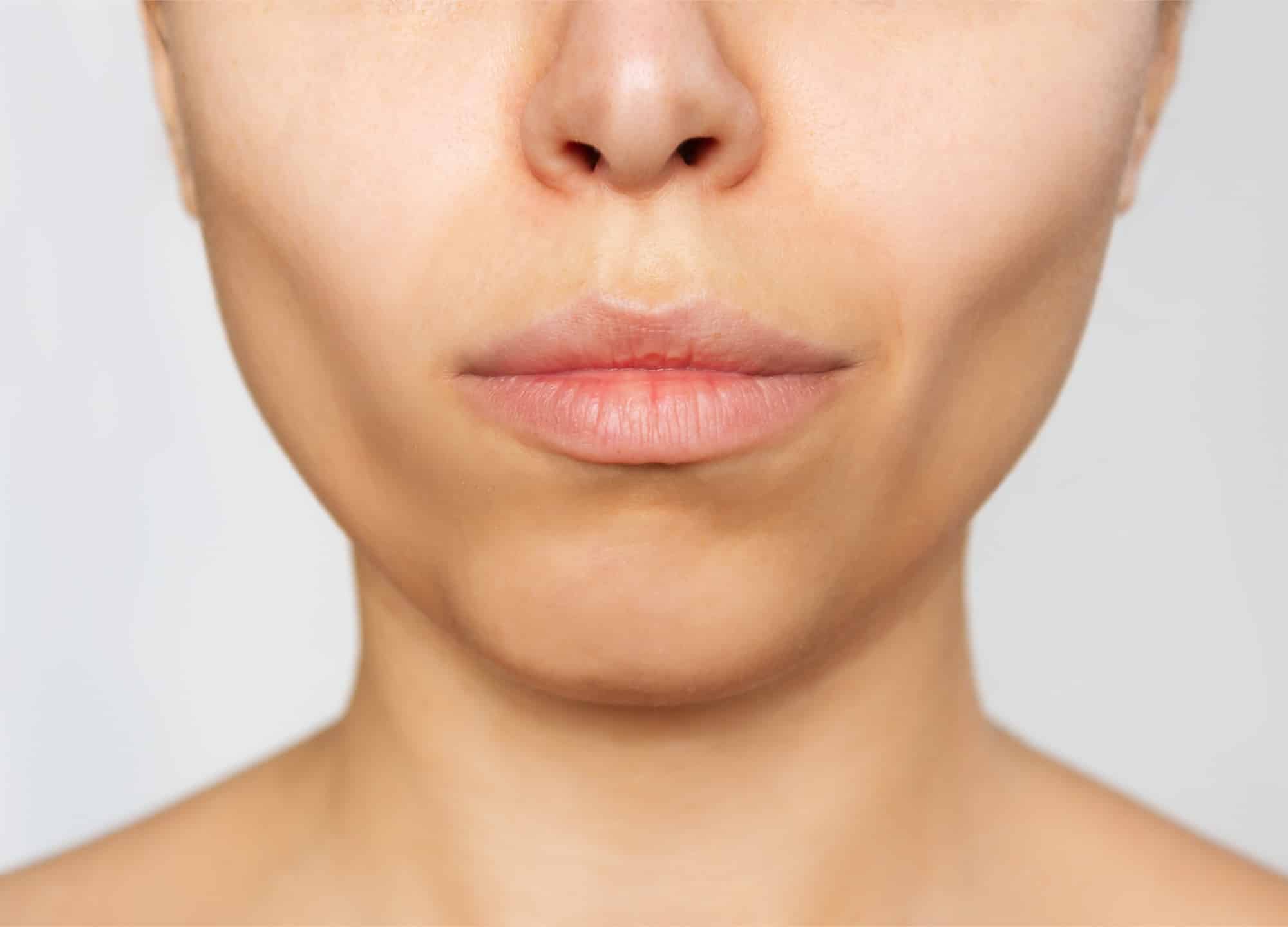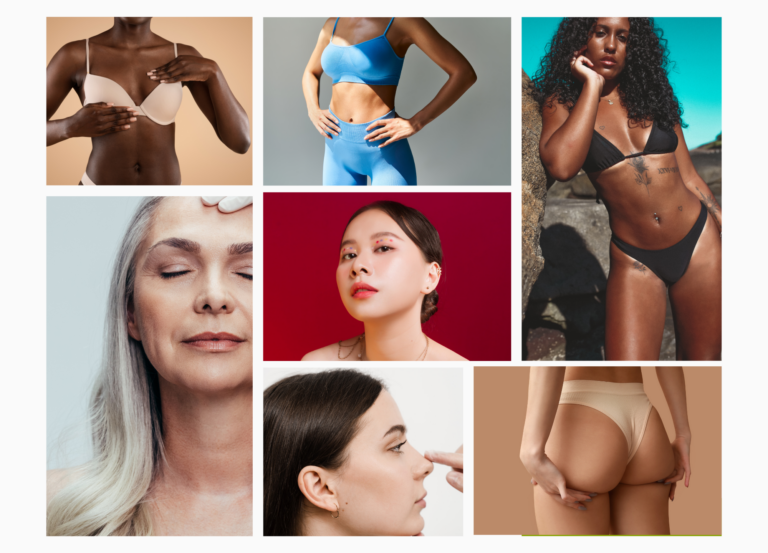Buccal fat removal entered our collective consciousness several years ago, after the procedure exploded on Instagram, giving us a new feature to scrutinize: our cheek hollows. Of course, as with most social media “discoveries,” the procedure was nothing new. Plastic surgeons have forever been tinkering with buccal fat, to quietly sculpt lower faces during facelift surgery. Regardless, viral fat-extraction videos and celebs endorsements and changed appearances (Chrissy Teigen raved about her results, selfies of Lea Michele sparked rumors galore that she had the procedure done) elevated buccal fat removal to something of a plastic surgery phenomenon—and its popularity continues to soar. According to the latest stats from The Aesthetic Society, its members performed 68% more buccal fat excisions in 2021 than they had the year before.
As anyone who’s mastered the pronunciation of buccal (buh-kl) no doubt knows, a fair amount of controversy surrounds this famous fat pad and the prudence of mining it for supermodel-caliber, Bella-Hadid-inspired angles—largely because “there is insufficient long-term data … as it pertains to any possible future consequences of buccal fat removal on facial aging,” explains Dr. Danny Soares, a board-certified facial plastic surgeon in Fruitland Park, Florida. Doctors aren’t entirely sure how buccal fat–subtracted cheeks may fare as people get older, when the myriad tissues of the face inevitably deflate, erode, and descend.
Buccal fat removal regret is real
It’s important to first understand exactly what buccal fat is and the purpose it serves in the overall facial structure. “When surgeons remove buccal fat, they’re taking only a portion of fat from the lower cheek,” adds Dr. Soares. But that yellow glob you’ve seen plucked from countless influencers’ mouths on TikTok videos (or the roundness you see in the mirror) hardly captures the true bounty of buccal fat. The buccal fat pad (aka Bichat’s fat pad) is actually made up of several deep and superficial segments, or lobes, situated throughout the cheeks and extending back toward the jaw and up into the temples. Beyond lending copious volume to the midface, it serves as a sort of shock absorber, helping muscles move with ease and buffering underlying nerves and vessels.
Many surgeons insist that when buccal fat reduction is done conservatively, in good candidates—“younger adults with a normal BMI but an overly round face due to excess fullness of the lower cheek region,” notes Dr. Soares—that satisfaction rates are high and regrets are unlikely. These patients notice a “subtle but significant difference,” he says, and often wish that even more fat could be removed.
But some plastic surgeons are starting to see a bit of blowback from the buccal removal craze—prematurely wizened cheeks that can be difficult to restore to their original proportions. While the short term effects of the cosmetic surgery may be exactly what patients want, the longterm results of buccal fat removal aging are very real. “I see it a lot in patients who are somewhat older and had [buccal fat reduction] done when they were young and now look much older than they are, as their face is depleted,” says Dr. Rod J. Rohrich, a board-certified plastic surgeon in Dallas. Sometimes buyer’s remorse surfaces far sooner. “I recently saw a Hollywood star who had buccal fat pad removal a year ago and is now distraught [because] he looks 10 years older and gaunt,” Dr. Rohrich shares.
Do you naturally lose buccal fat as you age?
In a word, yes, which is why not every patient aiming to beef up their buccal hollows has had fat surgically extracted. For some, age has sculpted their cheeks in unwanted ways. Beverly Hills, California, board-certified facial plastic surgeon Dr. Sarmela Sunder says that while she has seen “several patients wanting to restore an area of previous buccal reduction,” the majority of folks seeking buccal augmentation are aiming to reverse age-related changes, not surgical side effects.
Similarly, Dr. Steven R. Cohen, a board-certified plastic surgeon in San Diego, tells us that about 25% of people who come in for facelift surgery have “extensive losses in the buccal region”—again, due to natural aging. He tends to see it more in Slavic patients with pronounced cheekbones. He adds, “I’m not sure it’s 100% related or just accentuated”—the peaks of their facial topography making the adjacent valleys appear extra cavernous. We should note, there is debate among doctors as to how the buccal fat pads change over time. Do they truly atrophy—or do they just drop? If they shrivel, how much volume is lost? The answers are likely unique to the individual, with some people having persistent buccal bulges for life (those genetically prone to so-called ‘chipmunk cheeks’) and others developing gaunt hollows due, in part, to disappearing buccal fat.
Can buccal fat removal be reversed?
Kind of, but it’s not quite as easy as it may seem. In most parts of the face, volume loss is easily addressed with hyaluronic acid (HA) filler. When injected properly, these temporary gels subtly inflate hollows, like tear troughs and temples, smoothing the area to restore youthful contours and diminish shadows. But the architecture of the buccal hollow—or lack of architecture—makes the area tricky to treat with traditional fillers. “If you think about the face, almost every time we inject HA, we use the bony skeleton as the buttress for our filler—but there is no bony support in the buccal hollow,” says Dr. Jason Bloom, a board-certified facial plastic surgeon in Bryn Mawr, Pennsylvania. “You can dump four syringes of filler on each side and not see any improvement.”
For this very reason, “I consider that area to be like the Grand Canyon for HA fillers,” adds Dr. Michael Somenek, a board-certified facial plastic surgeon in Washington, D.C. “Because you have no underlying foundation to give the gel resistance, it kind of expands in all directions” rather than building upward and outward to fill the space, he explains. If injected too deeply, the gel gets lost and has no payoff. If placed too superficially, it creates visible lines, lumps, and bumps. “It’s just never really giving me what I want in this area,” Dr. Somenek says.
Not only is this part of the cheek pliable and relatively thin, but it contains “a lot of highly mobile muscles, which contract when we speak and animate—so HA filler, in a lot of cases, can look very bulky and unnatural in this unforgiving area,” says Dr. Sunder. HAs may also metabolize much quicker here, she notes, due to the constant muscle action. “This isn’t to say I never use HA in the buccal area—I do,” she adds. “There are some thinner, lighter fillers that can look good,” but they’re rarely her treatment of choice.
The best options for buccal fat removal reversal
Nonsurgical plumping
A better solution, our experts say, is non-HA biostimulatory injectables, like Sculptra and hyperdilute Radiesse. Drs. Bloom, Somenek, and Sunder call Sculptra their “go-to for this area” because it is so forgiving. (“I have the same confidence in hyperdilute Radiesse that I do in Sculptra,” adds Dr. Somenek.) When injected into the subcutaneous plane, found just below the dermis, these suspensions trigger fibroblast cells to churn out collagen, thickening up the tissue in a natural-looking way.
With both products, “we’re injecting the patient two or three times over the course of several months and seeing a nice, gradual softening to this area,” says Dr. Somenek. “With the collagen stimulators, it’s all about subtle volumization, which is why I like them for [the buccal hollow]. There’s something to be said for maintaining a little bit of concavity here, because it gives you that accentuation of the cheekbones.”
Sculptra and dilute Radiesse also reportedly improve the skin’s radiance and texture—studies are currently being done, to quantify these effects—and this is another reason our experts like them for sunken cheeks, which are often punctuated by smile lines. Speaking about Sculptra specifically, Dr. Bloom says, “when you’re generating a significant amount of dermal collagen, you see a quality improvement in the skin—it’s definitely one of the first things you notice.”
Surgical fat grafting
Plastic surgeons also rely on facial fat grafting to restore the buccal hollows—especially for patients who are already having some other type of facial surgery or cosmetic procedure, like a facelift, blepharoplasty, or more extensive fat grafting.
“Even if a patient is not having surgery, I still prefer fat grafting the buccal hollow because that’s what belongs there,” says Dr. Cohen. (Fat also offers a more lasting correction compared to injectables, assuming patients maintain their weight.) To restore buccal fat and create structure, he injects microfat directly into the buccal fat pad. While this can be done from inside the mouth (as seen here), Dr. Cohen typically accesses the buccal space through a puncture at the corner of the mouth, he explains, adding enough fat to improve the hollow while still “maintaining that low-light area” for a pretty contour. He then injects a specific type of nanofat—what he calls “a cell-optimized graft”—more superficially, to improve skin texture and hyperpigmentation.
Dr. Rohrich also places fat deep into the buccal space but admits “this is a difficult thing to do [and requires an approach that is] very different from most grafting techniques.” Indeed, the buccal compartment houses various glands, ducts, veins, arteries, nerves, and lymphatic channels in addition to fat. Some surgeons avoid it altogether when fat grafting and instead aim to plump the subcutaneous tissue above it. Regardless of technique, all of our surgeons agree that it requires great skill and experience to fat graft the buccal hollow to undetectable effect, particularly on the lean, thin-skinned patients who are most commonly seeking this treatment.
Does buccal fat removal age you?
The short answer: It can, but this is largely dependent on the individual. Plastic surgeons are fielding more complaints of gaunt cheeks, which are usually a by-product of age-related volume loss but occasionally result from buccal fat removal surgery. In Dr. Soares’ experience, selecting the right patients for this procedure can obviate long-term problems. “Ideal candidates—who are young, with normal BMIs and a cherubic facial shape—are not likely to end up volume-depleted now or in their later years,” he tells us. When buccal fat is taken from the wrong patient—or reduced more than it should be—the procedure does have the potential to make people look old prematurely.
Regardless of the cause, dwindling cheek fat can give the face a skeletal look and may, over time, exacerbate cheek wrinkles, nasolabial folds, and jowly jawlines. However, as Dr. Soares points out, the aforementioned buccal fat loss that occurs with age doesn’t happen in a vacuum—it coincides with gradual bone loss, muscle and ligament deterioration, and fat shrinkage throughout the face. So while your cheek hollows may suddenly seem glaring, “the loss of buccal fat is not likely the predominant factor leading to [an aged appearance],” according to Dr. Soares.
Filling out the cheeks with fat or injectables can certainly blend away distracting hollows; however, “we’re very infrequently treating the buccal area alone,” notes Dr. Bloom. Ultimately, you’ll want to strategize with a board-certified plastic surgeon or dermatologist on how to balance the contours of your face in a way that ages beautifully and looks undeniably authentic.











